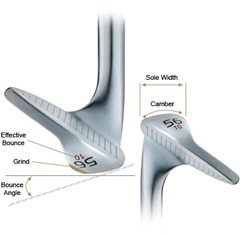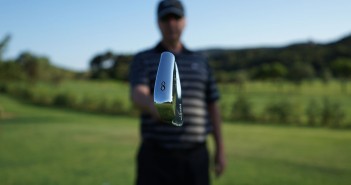Wedges are all about scoring, about getting you as close as possible to the pin, and that means distance control.
Two thirds of all golf shots are from 125 yards (114m) and in, making consistent wedge play a key to lower scores.
In our Short Game series, we’ll teach you how to play every shot, to finesse your wedges for fine control over distance, trajectory and spin.
But it really helps if you have the right tools in your bag – and that means carrying more than just the traditional PW and SW.
In selecting your wedge configuration, there are three main characteristics to consider: loft, bounce, and lie angle.
Loft
Loft is the primary consideration when selecting your wedges. Loft will determine, for your swing, how far you will hit the ball.
When selecting your wedges, you should start with the loft of the shortest iron in your set – this will usually be a pitching wedge (PW) with about 45° to 47° of loft.
At the other end of the range, you should carry a lob wedge.
If you currently find it difficult to hit a lob wedge, don’t worry. With our help, this will soon become the most effective and versatile tool in your bag.
Since the change in the regulations governing groove shape, many manufacturer’s 60° wedges will now hit the ball too high and with not enough spin for accurate control. Most of our elite students stopped carrying 60° when the rules changed, but recent advances in groove and face milling technology amongst some of the best wedge manufacturers has made them more popular again.
In general, we prefer a 58° lob wedge, which will give you more control and versatility. This will soon become your scoring weapon of choice.
In between your PW and lob wedge, you need to fill in the gaps.
While you can achieve high levels of distance control with your swing, it’s still necessary to have a good selection of lofts.
Ideally, you will have an even gap of 4° to 6° between each wedge. This will give you consistent distance gaps of about 12-15 yards (11-14m) between each wedge, for a full shot.
We recommend the following set configurations, depending on the loft of your PW:
| Pitching Wedge (PW) | Remaining Wedge Set Composition | |||
| 3 Wedge Configurations | 46° | 52° | 58° | |
| 48° | 53° | 58° | ||
| 4 Wedge Configuration | 46° | 50° | 54° | 58° |
Most players will benefit from carrying four wedges, giving tighter yardage gaps, and thus enabling you to play more full shots.
The precise gaps between each wedge should be adjusted depending on how far you hit each club with a full shot from the fairway.
If you’re asking “which one is my sand wedge?” then the answer is “all of them!” In our Bunker Play series we’ll teach you how to use a variety of clubs, depending on the conditions, to get the ball out and close to the pin every time – including your 7 iron!
Bounce
The role of bounce is to stop the golf club digging, allowing it to glide through the turf or sand, which helps you execute better shots in a variety of conditions.
Bounce angle is the angle between the leading edge and the lowest point on the sole. Most lofted wedges have between 3 and 16 degrees of bounce.
Wedges are usually marked with an “effective bounce”, which is an indicator of how the wedge will play. Effective bounce is determined by bounce angle, sole width, sole grind and camber.
The amount of bounce that you require depends on the playing conditions and on the shape of your swing.
The way that we teach the short game, you will learn a relatively shallow, flatter, golf swing as you release through impact. This means that your wedges should have mid- to low bounce. We’ll teach you how to control the amount of bounce presented to the sand or turf in order to play different shots in varying conditions.
If you normally play your golf on soft turf, then you should choose slightly more bounce, and in firm conditions choose less bounce.
It’s useful to have a variety of bounce available when playing, and for normal conditions a great combination would be a 58° wedge with 12° of bounce, and a 52° wedge with 8° of bounce.
The best wedges have sole grind that enables you to control the amount of bounce presented to the ground depending on the club’s face angle, thus giving you a lot of versatility. Vokey SM5 are excellent here, with a wide choice of sole grinds to choose from to suit different playing conditions. Our favourite combination would be a lob wedge with K-grind together with a gap wedge with M-grind – these have plenty of bounce and versatility, and they suit the pitching & chipping technique that we teach perfectly.
Lie Angle
As with all golf clubs, your wedges should have a lie angle that is suitable for your build and your swing.
Because we teach a slightly flatter short game swing, we recommend a slightly flatter lie angle on your wedges – about 2° flatter than standard, after adjusting for your body proportions.
Note that the playing characteristics of your wedges can be easily modified by your club fitter, who can bend the club to fine-tune the loft and lie angle, and even shave the sole of the club to change the shape of the bounce, depending on your needs.
Ultimately, the goal is to have a set of wedges that enables you to play the full variety of full and short shots that you will need on the course.
Happy fairways!

» Pitch Like a Champion – Get Up and Down from Any Lie.





